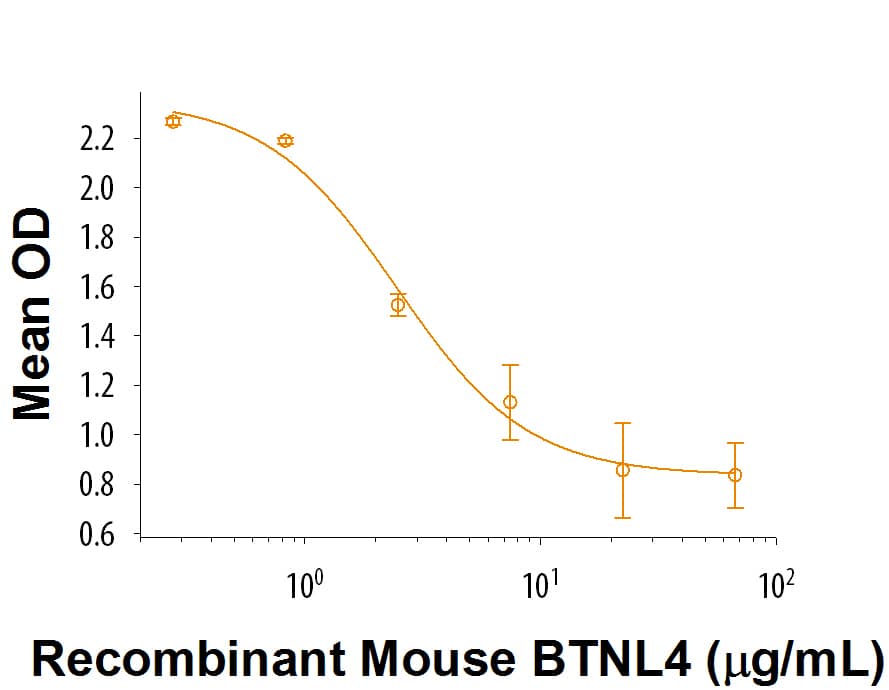Recombinant Mouse BTNL4 Fc Chimera Protein, CF
R&D Systems, part of Bio-Techne | Catalog # 9590-BT

Key Product Details
Source
NS0
Accession #
Structure / Form
Disulfide-linked homodimer
Conjugate
Unconjugated
Applications
Bioactivity
Product Specifications
Source
Mouse myeloma cell line, NS0-derived mouse BTNL4 protein
| Mouse BTNL4 (Gln29-Trp250) Accession # NP_109671 |
IEGRMDP | Mouse IgG2a (Glu98-Lys330) |
| N-terminus | C-terminus |
Purity
>95%, by SDS-PAGE visualized with Silver Staining and quantitative densitometry by Coomassie® Blue Staining.
Endotoxin Level
<0.10 EU per 1 μg of the protein by the LAL method.
N-terminal Sequence Analysis
No results obtained: Gln29 inferred from enzymatic pyroglutamate treatment revealing Glu30
Predicted Molecular Mass
52 kDa
SDS-PAGE
59-66 kDa, reducing conditions
Activity
Measured by its ability to inhibit IL-2 secretion by mouse T cells in the presence of anti-CD3.
The ED50 for this effect is 1.5-7.5 μg/mL.
The ED50 for this effect is 1.5-7.5 μg/mL.
Scientific Data Images for Recombinant Mouse BTNL4 Fc Chimera Protein, CF
Recombinant Mouse BTNL4 Fc Chimera Protein Bioactivity
Recombinant Mouse BTNL4 Fc Chimera (Catalog # 9590-BT) inhibits IL-2 secretion by mouse T cells in the presence of anti-CD3 antibody. The ED50 for this effect is 1.5-7.5 μg/mL.Formulation, Preparation and Storage
9590-BT
| Formulation | Lyophilized from a 0.2 μm filtered solution in PBS. |
| Reconstitution |
Reconstitute at 200 μg/mL in PBS.
|
| Shipping | The product is shipped at ambient temperature. Upon receipt, store it immediately at the temperature recommended below. |
| Stability & Storage | Use a manual defrost freezer and avoid repeated freeze-thaw cycles.
|
Background: BTNL4
References
- Yamashiro, H. et al. (2010) J. Leukoc Biol. 88:757.
- Compte, E. et al. (2004) Eur. J. Immunol. 34:2089.
- Abeler-Dorner, L. et al. (2012) Trends Immunol. 33:34.
- Bas, A. et al. (2011) Proc Natl Acad Sci U S A. 108:4376.
Long Name
Butyrophilin-like 4
Alternate Names
BTN3A3, EG632126, NG11
Entrez Gene IDs
632126 (Mouse)
Gene Symbol
BTNL4
UniProt
Additional BTNL4 Products
Product Documents for Recombinant Mouse BTNL4 Fc Chimera Protein, CF
Product Specific Notices for Recombinant Mouse BTNL4 Fc Chimera Protein, CF
For research use only
